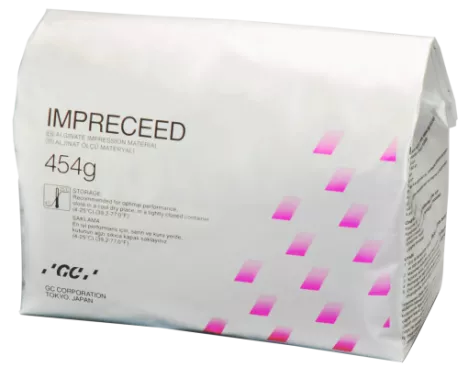A Dust-Free Alginate Impression Material for Dental Impressions
09/20/2022
IMPRECEED
Alginate Impressions: All You Need To Know About
Numerous dental procedures and equipment are specially made to fit comfortably in the mouth. Dental impressions enable dentists to design oral appliances that will easily fit over the surfaces of patients’ teeth. They utilize a material called alginate to create these impressions. Find out more about alginate and its use by dentists.
What Are The Uses of Alginate Impressions?
Dental impressions are required for any appliance that must fit over or replace one of your teeth, including:
● Bridges
● Veneers
● Crowns
● Braces (and other orthodontic appliances)
● Customized whitening trays
Even when saliva is present, alginate impression material still creates accurate dental impressions because it responds well to water. Your dentist will be able to produce a model of your dental arch with the aid of a correct impression of the teeth and gums. The dental device will then be customized using this.

Alginate Impression Material – The Heart of a Good Restoration
Based on GC’s extensive knowledge of alginate materials, IMPRECEED has been designed to offer users final impression of the highest quality combined with an easier and faster mixing.
Features And Benefits
Advantages:
- Advanced formulation
- Easy and rapid powder incorporation into water within just 3 seconds
- Dust free formulation allowing fast and vigorous mixing for a smooth mixture without bubbles
- Ideal thixotropic property
- Does not leak down the patient’s throat during impression taking
- Under pressure the alginate flows into the narrowest spaces for highest detail reproduction
- Laboratory optimized
- Compatible with a wide range of type IV stones for a better detail reproduction
- Smooth model surface
- Spearmint flavour for patient comfort
- Available in 2 setting types: Fast and Normal set

Indications:
Impression taking for temporary indirect restorations, orthodontic models and study models.
Advantages:
- Easy and rapid powder incorporation into water within just 3 seconds
- Dust free formulation allowing fast and vigorous mixing for a smooth mixture without bubbles
- Under pressure the alginate flows into the narrowest spaces for highest detail reproduction
- Compatible with a wide range of type IV stones for a better detail reproduction and smooth model surface
- Spearmint flavour for patient comfort
A Method For Making an Alginate Impression
During your initial consultations, dental impressions are taken. To clear the mouth of debris and partially dry the mouth, your dentist will begin by cleaning your teeth. The alginate powder and water will be combined to produce a smooth, spreadable consistency. The mixture is then poured onto an impression tray with a u-shape that fits over the arch of your teeth.
Depending on where the dental procedure is being done, the tray will be securely positioned on the upper or lower teeth for a few minutes. If you have a gag reaction, let your dentist know. For the reflex to stop and relax, they could give you nitrous oxide, sometimes known as laughing gas.
The Mixing and Loading of Alginates
Alginate materials that are often utilized are provided in containers. The powder is measured with a scoop, and the water percentage is measured with a plastic measuring cylinder. Some water sources have high mineral content, which can impact the accuracy and alginate setting time. Demineralized or distilled water may be utilized in these circumstances.
Water is added in the proper amount to a clean, flexible rubber bowl to begin the mixing process. After that, the powder is added in the appropriate amount. If you want to work for a longer period, use colder water. The water temperature should be adjusted to manage setting time rather than mix consistency.
By using a spatula with a wide blade, mixing should be quick. The final mixture must have a creamy consistency without dripping when the spatula is removed from the bowl. For hand speculation, the mixing period is 60 seconds; for mechanical, it is 15 seconds. The tray is filled with the necessary amount of material.
The impression material must fill the tray to the tray borders, and any extra unsupported material (overfilled tray) at the edge must be scraped with the mixing spatula. A wet gloved finger is used to smooth the alginate’s surface.
The Mouth Must Be Prepared Before Impressions Can Be Taken
In order to reduce air blows, it is best to blow off the occlusal surfaces of dentate cases’ teeth with an air syringe to remove saliva and debris. However, the teeth shouldn’t be allowed to dry thoroughly since once the thin film that covers the teeth is removed, Dustfree alginate material adheres to dried teeth.
When surfaces are dry, alginate radicals in the impression material create chemical interactions with hydroxyapatite crystals of the enamel, causing alginate to break upon removal. Mucin will be removed, and the surface tension will be lowered, reducing air bubbles when the patient rinses with water and mouthwash.
Repetitive alginate impression-taking prevents a decent impression by removing the film covering the teeth. For repeat impressions to be correct, the patient must be instructed to rinse their mouth to rehydrate and create a fresh film over their teeth.
The sulci impressions are crucial for removable prostheses. Pre-packing of the sulci should therefore be considered, especially in the lower lingual, upper labial, and hamular notch/distobuccal areas.
Inspecting and Removing Impressions
Once the impression has dried, it must be removed with a swift, hard snap. Before or while the impression is removed, it shouldn’t be rocked or twisted. It reduces the time the set material is warped as it passes over the teeth. Before removing maxillary impressions, breaking the seal between the tissues and the impression may be necessary.
To do this, gently press the gloved finger into the buccal sulcus or use an air syringe to break the seal. The operator’s index fingers on both hands should be in the buccal sulci during the removal of the maxillary impression to break the seal. At the same time, the thumb secures the tray handle, and the other fingers hold up the impression tray.
After being taken out of the mouth, the impression is examined for flaws before being rinsed under good lighting. To get rid of saliva or blood, rinse the impression with cold water. Saliva in most patients is thin and serous. You can get rid of this kind of saliva by keeping the impression under a gentle stream of cool water.
However, it is challenging to remove thick, ropy saliva. You can lightly sprinkle the dental stone powder over the impression’s surface. The stone serves as a revealing agent by sticking to saliva. Removing saliva by lightly brushing with a damp camel hair brush after placing the impression under running tap water is possible.
In order to avoid syneresis, the impression should next be covered in damp gauze or a napkin. A sharp knife should be used to remove any extra unsupported alginate. The impression would droop if the tray were left on a solid surface with unsupported material because the weight of the impression directly presses against the unsupported material.
The Storage and Disinfection of Infectious Materials
If set alginate is left in a typical clinical setting, imbibition and syneresis occur. Before cast-pouring, timing is essential. Alginate impressions should be cleaned with a water spray after being taken out of the mouth, cleaned and disinfected using the dentist’s preferred methods, and dried until the shine fades away.
Before the cast is poured, the impression must be wrapped in wet gauze and kept in a zip-lock bag. As the alginate impression material recovers slowly, the casting must wait 10 minutes before pouring. If disinfection rules are not strictly followed, distortion may be an issue. Due to their hydrophilic nature, hydrocolloids enlarge when exposed to water or a disinfectant.
For alginate impressions, disinfectant sprays are employed; however, the cast does contain air bubbles as a result. Immersion disinfectants such as 1% sodium hypochlorite or 2% glutaraldehyde can cause variations of 0.1%, so the condition of the impression surface may not be compromised if the specified time duration is carefully followed.
A crucial component of orthodontic and restorative procedures is taking impressions of your teeth. Dentists use detailed impressions to create custom-fit appliances that won’t irritate or hurt patients. Consult your dentist if you have any concerns regarding an active gag reflex. They are present to make you feel comfortable.



